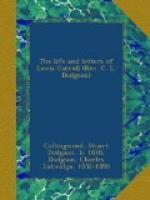Become whatever good you see;
Nor sigh if, forthwith,
fades from view
The grace of which you may
not be
The Subject and
spectator too.
The reading of “Alton Locke” turned his mind towards social subjects. “If the book were but a little more definite,” he writes, “it might stir up many fellow-workers in the same good field of social improvement. Oh that God, in His good providence, may make me hereafter such a worker! But alas, what are the means? Each one has his own nostrum to propound, and in the Babel of voices nothing is done. I would thankfully spend and be spent so long as I were sure of really effecting something by the sacrifice, and not merely lying down under the wheels of some irresistible Juggernaut.”
He was for some time the editor of College Rhymes, a Christ Church paper, in which his poem, “A Sea Dirge” (afterwards republished in “Phantasmagoria,” and again in “Rhyme? and Reason?"), first appeared. The following verses were among his contributions to the same magazine:—
I painted her a gushing thing,
With years perhaps
a score
I little thought to find they
were
At least a dozen
more;
My fancy gave her eyes of
blue,
A curly auburn
head:
I came to find the blue a
green,
The auburn turned
to red.
She boxed my ears this morning,
They tingled very
much;
I own that I could wish her
A somewhat lighter
touch;
And if you were to ask me
how
Her charms might
be improved,
I would not have them added
to,
But just a few
removed!
She has the bear’s ethereal
grace,
The bland hyena’s
laugh,
The footstep of the elephant,
The neck of the
giraffe;
I love her still, believe
me,
Though my heart
its passion hides;
“She is all my fancy
painted her,”
But oh! how
much besides!
It was when writing for The Train that he first felt the need of a pseudonym. He suggested “Dares” (the first syllable of his birthplace) to Edmund Yates, but, as this did not meet with his editor’s approval, he wrote again, giving a choice of four names, (1) Edgar Cuthwellis, (2) Edgar U. C. Westhall, (3) Louis Carroll, and (4) Lewis Carroll. The first two were formed from the letters of his two Christian names, Charles Lutwidge; the others are merely variant forms of those names—Lewis = Ludovicus = Lutwidge; Carroll = Carolus = Charles. Mr. Yates chose the last, and thenceforward it became Mr. Dodgson’s ordinary nom de plume. The first occasion on which he used it was, I believe, when he wrote “The Path of Roses,” a poem which appeared in The Train in May, 1856.
On June 16th he again visited the Princess’s Theatre. This time the play was “A Winter’s Tale,” and he “especially admired the acting of the little Mamillius, Ellen Terry, a beautiful little creature, who played with remarkable ease and spirit.”




